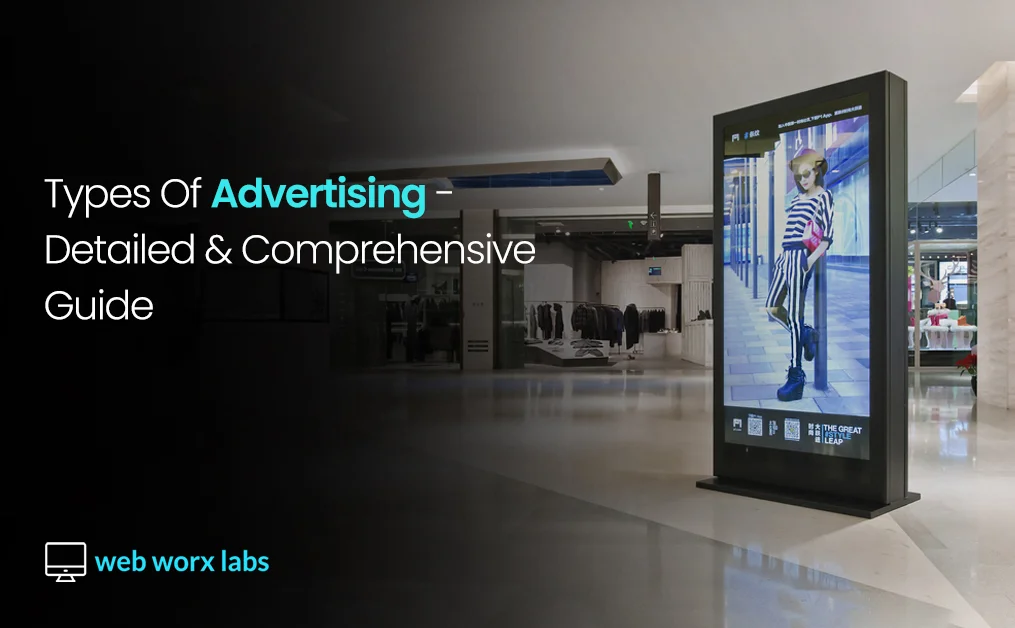Types of Advertising
Types of Advertising – Detailed & Comprehensive Guide
Advertising? The most significant form of marketing communication done to promote or sell a solution through a non-personal message and openly sponsored format.
Arguably the most popular discipline within the marketing function.
Introduction
There are several types of advertisings. However, not many people are fully aware of them.
Although now the current generation knows what exactly advertisements do but still to sound a bit academic, let us give you a more detailed overview and begin by looking at the very definition of advertising.
“The businesses are trying to persuade people to buy products or services.”
It’s the act or practice of swaying towards a purchase.
Several ways have been introduced from traditional/legacy media to new/modern media?
The history of advertising can be traced to ancient civilization when Egyptians used papyrus (thick paper) to make wall posters and write sales messages.
Advertisers have a vast array of choices, and in this blog, we’ll lay out many of the types of advertising.
Advertising is communicated through various media formats; it can be either through traditional media or digital media.
Today, we breakdown the different media that are available for businesses and brands to consider when looking to advertise.
Traditional Media
This form of media communicates with one-way technologies, involve print media.
We can further classify media into direct mail, newspaper, magazines, outdoor advertising, radio broadcasting, and television.
New Media or Digital Advertising
This form of media enables people to telecommunicate with each other through search engine results, websites, articles, blogs, social media platforms, and text messages.
You can even call new/modern media digital media because of the use of electronic devices.
Both types of advertising are still in use, but with the advent of new media, traditional media has faced many challenges.
Which doesn’t mean that it has lost its worth.
With the advancements in digital media, it is said that advertisers had spent $40 billion more on internet ads than on TV ads last year.
You can also check the full stats of global advertising spending here from 2014 to 2021.
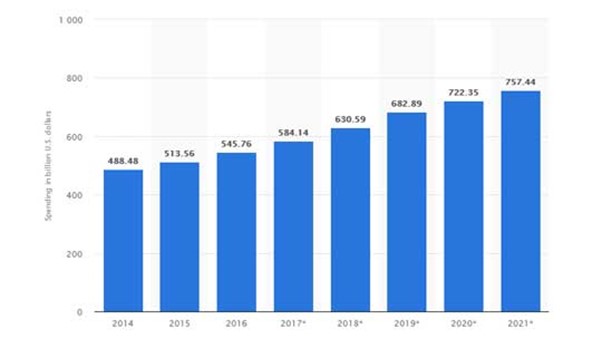
Image source; Statista – Worldwide spending in Advertising in billions
Today, businesses want to promote their brands and services by capturing the minds of people through new methods.
Worldwide the estimated spending on advertising is undoubtedly going to increase in the upcoming years, as businesses want to promote their brands and services by capturing the minds of people through new methods.
A good marketing strategy for brands includes a good dose of offline or traditional marketing and digital marketing.
Are you curious to know about the tactics used in advertising to reach consumers?
The following list is our approach to provide a detailed and comprehensive overview of the types of advertising options available to a brand large or small. By now means is this list complete, but a good guide with lots of options depending on your unique needs and your marketing mix.
The following list will help your business to grab the attention of your targeted audience to generate higher exposure, visibility and overtime growth for your business.
We begin our breakout with traditional media and then get into digital advertising to round out a complete picture.
Direct Mail

Image Source: Aviaro
In advertising, direct mail is one of the oldest types in which prospective buyers receive a message by post or mail service.
Direct mail is used by businesses in which they send letters, brochures, catalogues, postcards, and promotional material to their potential clients and customers.
The most significant advantage of this type of advertising is it allows you to communicate with your targeted audience one-on-one. This method is beneficial as it provides direct and detailed information about the product sent to the buyers and attempts to establish direct contact with the consumer.
In contrast, in other types of advertising, you’re never 100% sure who is receiving your message.
There are disadvantages to this form of advertising as it suffers from certain flaws because it is sent directly to the clients. It has limited reach, and response rates are often low as many consumers throw direct mail pieces away without giving it a read.
This can get costly if the advertiser is not getting the desired result.
Be mindful of the fact that if you’re going to choose direct mail, you have to do it right.
For a particular demographic and buyer personas, this advertising type may still be useful. Know your customer, and if you feel that the communities and customers you are targeting open direct mail, this may be a great tried, true, and tested way to advertise.
Newspapers and Magazines

Image Source: MyImaginaryFriendGraphics
One of the most used formats in the 20th century to advertise to your target audience is by using print media. This format usually comes in two mediums of communication, i.e., newspapers and magazines.
As you may already know, print journalism has been in decline as such this medium is reaching far fewer people than it did in the past.
However, many still get printed newspapers on their doorstep. Besides, doctors, dentists, and lawyers’ offices are usually filled with magazines to help their patients or clients pass the time.
Newspapers are still essential
Even though the reach is shrinking, the right message can resonate with the target audience if done right.
Several benefits of newspaper advertising cannot be found elsewhere, including television, radio, or even the internet.
The cost of advertising is more affordable than many of the mediums and offers better targeting. Newspaper adverting allows brands to target a specific audience that is often difficult to reach through other mediums.
Newspapers effectively reach more customers because of the ability to be an engaging and trustworthy source.
However, given its declining reach, this channel for advertising should not be solely relied upon to get your word out.
Using Magazine Advertisement To Increase Your Ads Shelflife
You might be thinking, “it may seem pointless to advertise in magazines?”
The reason being that other mediums have reached millions of consumers and “who reads print magazines in this day & age?”
Well, it is not pointless. Hear us out on this one.

Because ads in magazines have a more extended staying power or shelf life than other digital ads that come and go.
You have the power to stay in the minds of the consumer much longer in comparison to other mediums by advertising in a magazine.
Advertisements in magazines are very creative vs. perhaps other simpler formats because of being colourful and “prestigious,” which appeals to the readers.
However, the cost of advertising in magazines is higher and has much less flexibility compared to newspapers.
A fun fact about magazine advertisements is that those published on the right-hand page are more expensive than the left-hand page.
Still, newspapers and magazines both can have a more significant impact and exposure because millions of people are still reading this in this day and age (in the post-COVID19 world).
In 2020, newspaper circulation still stood at 19.6 million copies (yes million) in the heart of the pandemic year within Canada alone. So people do get exposure to print.
If your target audience demographic leans older, in remote areas or has less access to the internet, then this medium of advertising should be a strong contender to get the message out.
Radio Advertising

Image Source: Adweek
When you’re thinking about methods of advertising to promote your business, radio might not be the first thing that comes to your mind.
Podcasts are on the rise. With over 18.5 million episodes and 525,000 active podcast shows, no wonder the transition to this form of audio info/entertainment is happening.
However, radio is still holding a good share of the market. Even in the post-pandemic world, the numbers have stayed steady if not increased in the 2020 year:

Source: Statista
Especially in the era of social media, radio might seem “dated” to the younger generation (those that are 37 years and younger today).
But radio can be something important when it comes to market your advertising depending on your target audience.
Radio advertising, as compared to other media, offers more affordability.
It also offers broad reach to the targeted audience and can be beneficial for your enterprise by delivering a timely message.
If you want to go with radio advertising, a few things you must keep in mind.
Among other broadcast mediums, which have visual appeal, radio can only impact your target audience through sound.
But it covers all types of listeners, whether literate or not, to advertise your product.
Don’t forget that people listening to your advertisement on the radio are probably doing something else at the same time, like doing household chores or driving.
They are likely multitasking (driving or working for example) and listening to your advertisement at the same time.
So, try to make your key information more prominent about the product you’re selling.
As with any other form of advertising, given the steady share in the market, it is a good medium to get your brand out there.
Television Advertising

Image Source: EuroBusinessInfo
Watching tv is one of the most common and modern leisure activities, and advertising on television is one of the fastest-growing mediums of marketing.
This type of advertising has gained substantial popularity among the masses these days.
TV advertising is the most dominant way to reach a large number of consumers. For baby boomers particularly – this is still the number one source of media consumption (in the post-COVID-19 era).
A great research study done by Global Web Index details the breakout by demographic here.
Because this medium includes sound and sight to convey the message to your audience.
Advertising on television allows you to show and tell a wide range of audiences by grabbing their attention.
Engaging television ads are not just walking and talking messages.
They foster emotions, empathy, and leave an ever-lasting impression on the viewer’s mind.
These elements make television ads costly compared to other mediums but also more effective and impressive.
Cinema Advertising

Image Source: Pinterest
Ever thought of advertising right before a movie starts at a movie theatre?
The ads broadcast in cinemas are just as same on television but have one privilege over their smaller screen counterparts. And that is the captive environment of the cinema in which the audience has no chance or option to change the channel, ignore it, not even easily walk away because they are at a movie theatre.
Also, did you know that cinemagoers are four times more likely to be emotionally involved in your ad than a television audience?
When they remember the movie – they also remember the advertisement displayed in between.
That is pretty powerful!
So, this option is one of the most creative and smart techniques to promote your brand and make sure your message is heard.
Undoubtedly, it can be – but with COVID19 and the future of the theatre industry in peril, this can have an impact on the viability of this option. Nonetheless, when and if it does get back to its usual audience sizes, this is a good option for marketers to use as an advertising medium.
When going for this advertising option, choose the timings and movie when you want your ad to appear on the big screen.
Options now exist to have your ad seen before the movie begins or during intermission.
In my opinion, it is always better to promote your brand before the film starts – because, in an intermission, many people leave for a break (and many North American movies do not offer the intermissions).
This type of advertising is much more expensive than other options discussed so far but does provide more contract and targeting and because of this has a higher value as it serves hundreds of people at once.
This can be effective and part of your marketing mix, if you have larger budgets and can afford expensive mediums to build lasting impressions.
Outdoor Advertising
OOH – stands for Out-Of-Home advertising.
Why this is out of home when radio can be out of home or cinema or other formats are definitely out of home is beyond me at this point. Nonetheless, it is a term that stuck.
As the name suggests, this type of advertising is created to reach consumers who are in a public place, or outdoors.
This advertising falls into four main categories:
- Billboards.
- Street furniture.
- Transits.
- Digital outdoor advertising.
Billboard advertising
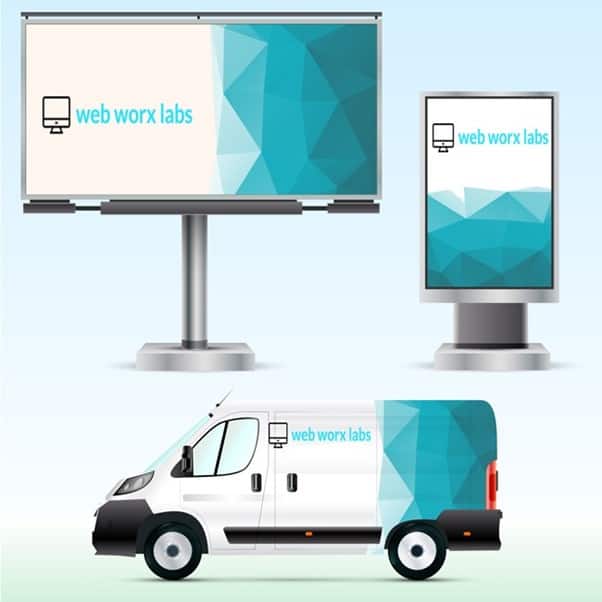
Image Source: FreeMockUp
We all are aware of what billboards are and can easily find them either on highly visible, heavy traffic areas or less-travelled roads in rural areas.
Drivers and travellers see them almost everywhere, as they are a cost-effective advertising method.
The stunning visuals on billboards leave an impression on the viewer and help you get the best bang for your buck.
Street Furniture
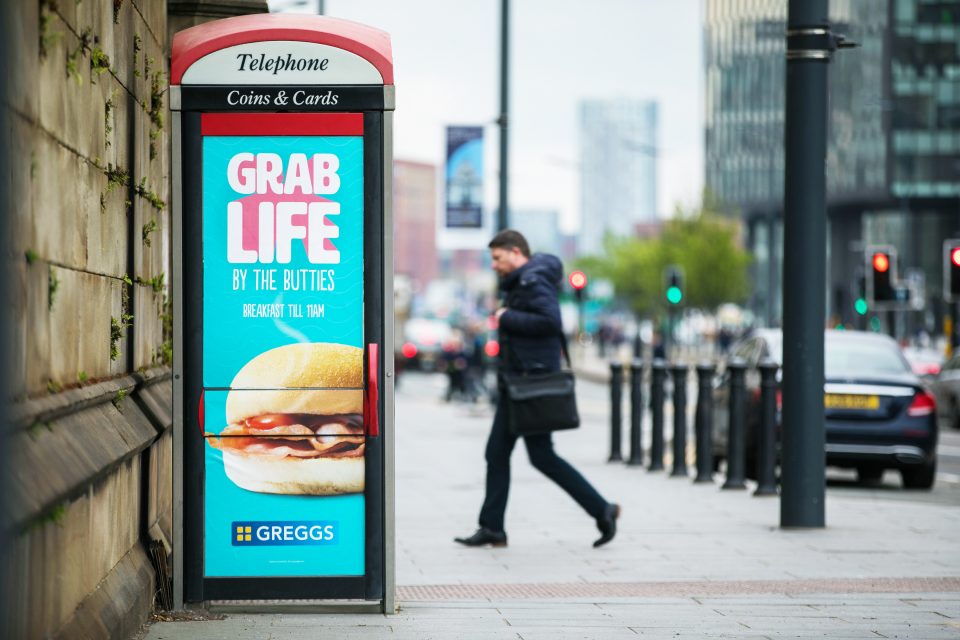
Image Source: Cityam
The use of street furniture for advertising is one of the efficient and cost-effective approaches.
Let us tell you what certain displays fall into the general category of street furniture such as benches in parks, busses and bus stop shelters, pole and telephone kiosks, news racks, etc.
Transit Advertising

Image Source: Local Advertising Journal
The most popular form of transit advertising is ads on the sides of the busses.
This is also common in subways, taxis, along airport walkways to highlight their products.
Digital Outdoor Advertising
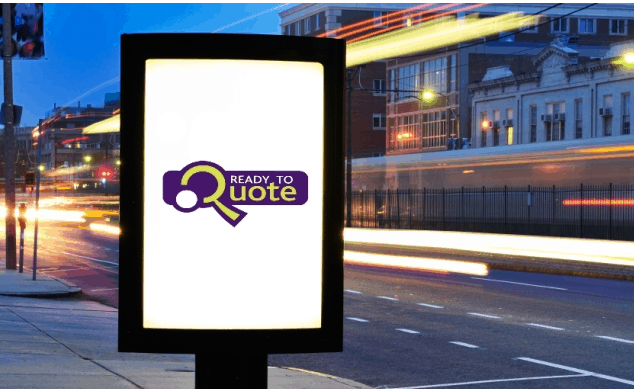
Image Source: ReadytoQuote
This type of advertising is also known as digital signage.
Electrical technology is used to change what is displayed on a screen.
This specific type of advertising has gained much popularity within modern times because of the advent of digital billboards, which easily attract consumers.
Ultimately advertising follows the consumers wherever they go, and all the categories mentioned above, offer ways to reach a broader audience in a local or regional market.
Great for general brand awareness and consideration of top-of-funnel advertising.
Digital Advertising
Unlike traditional advertising, digital advertising provides much more precision and control in reaching the target audiences.
The control in digital advertising comes from “cookies” or tags that are installed on a user’s machine when they visit a platform or a website.
This visit by the user gives the website owner pertinent intelligence that it can use in understanding, storing, defining the characteristics of demographic and preferences, taste, location, and historical buying and browsing patterns. These cookies assign a unique identifier for each visitor and allow the website owner to keep track of the same user when they revisit the site.
All different types of users visit this website or platform, and this massive amount of data is collected (big data) and synthesized. In essence, it gives the publishers, website owners or platforms a high level of precision to have advertisers place ads in front of a very targeted audience.
The platform or site can then sell this space to advertisers much the same way a newspaper does.
As an advertiser looking to advertise on the platform or website, you use the data to really segment and specify when, where, and how frequently you want your ad to appear.
Various types of publishers are available online, and these include search engines, social media platforms, video streaming services, and market places.
Pay Per Click Advertising
The most common form of online advertising is pay-per-click.
This form gives the advertiser to place ads in front of the target audience on the publisher’s platform.
The advertiser only pays when the user clicks on the ad.
Impressions are usually free (depending on the type of campaign you configure).
Is that not amazing in digital? That your brand can get exposure without having to ever pay for advertising when you configure most campaign types on Google.
This is a significant difference from traditional media formats where they charge for every time it is printed or distributed.
Here distribution is usually free, and only when the customer’s curiosity is intrigued, and he or she has shown interest, the publisher track and collects.
Related: Learn About Our Pay Per Click Advertising Services
Related: Learn About Digital Marketing Lead Generation With Advertising In Our Training Page
There are various forms of Pay-Per-Click advertising, including social media, search engine results pages, and video viewership.
Social Media Advertising
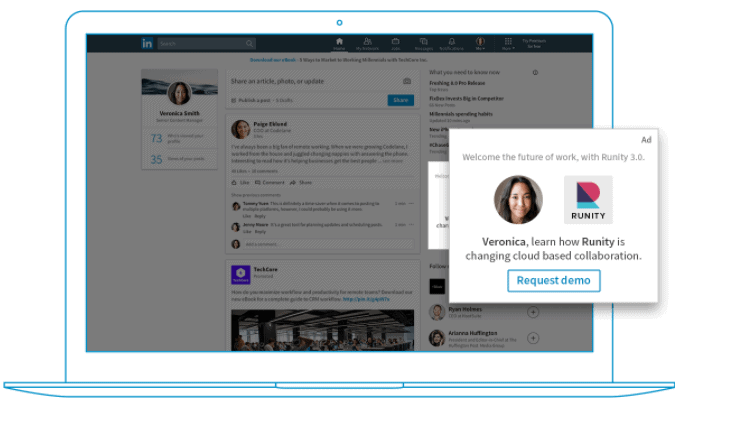
Image Source: Hootsuite
Most social media channels and platforms exist to monetize ways to provide advertising capabilities to the brands and companies for the users or traffic on their platforms. So they all offer pay-per-click advertising services.
While there are other advertising approaches, social media advertising has taken over the market by storm.
Whether you’re a B2B or B2C company, this strategy can help achieve your business objectives.
This type of advertising is used to grab the attention of the social media platform users to bring in consistent sales, awareness, leads, consideration or build trust and loyalty.
Social Media allows you to promote your brand in several ways; some of them are:
- In-stream ads
- Text-based ads
- Photo and video-based ads
Also, these help in increasing your fanbase/follower-base and or sales as well – depending on the type of campaign you configure in the social media platform.
From people engaging with your page (likes and engagement), to people booking appointments or giving their phone number to follow up are all options in this wide world of social media advertising.
Now the question is, which type of social media platform will help your business grow?
Here, we have compiled the list of influential social media advertising platforms you should be familiar with in 2021 (if not present and active in all of them):
- Facebook.
- Instagram.
- Twitter.
- Pinterest.
- LinkedIn.
- Snapchat.
- TikTok
You can take a look at all of these social media platforms and quickly find out which ads are worth your budget.
We understand there are many advertising options out there.
It might make it challenging to decide which ad platform you could get the best ROI from.
If you need help deciding whether social advertising is right for your business, you can ask us.
We’ll help you select the right ones or ones we believe may be the best fit for your brand given the business model you have. You will need to narrow down what your short and long-term goals are as well. If you are looking for immediate sales then certain types of ad campaigns on specific platforms may yield better results on social media vs. other options.
On the other hand, if the goal is long-term brand building and you already have a good presence on one social media channel (or ought to have given your audience hangs out there) – then, it is a good idea to advertise and stay on top of mind with longer-term campaigns for brand awareness and consideration.
Related: Our Social Media Marketing & Management Services
YouTube Advertising
With the increase of viewership on YouTube, no blog on advertising will be complete if there is no mention of YouTube.
More than 3/4 of the adults in the US use YouTube according to research shared on Hootsuite’s blog.
That is a huge number of users and they are only increasing!
We covered television and social advertising earlier, but this medium has so much content that is consumed and uploaded on a daily basis that it is becoming the go-to spot for an increasing number of brands to get the word out about their brand via ads, original content creation and influencer collaborations.
It is like a mix of TV, social and influencer forms of advertising all rolled up into one.
Really recommended for most brands who want to get a good message out and build brand impressions over time. Not so much as a lead generation mechanism, but a good tool to showcase thought expertise, build trust and create awareness.
Amazon Advertising
Do you sell on Amazon? Or are you an e-commerce brand that is considering amazon?
If you are an e-commerce brand and want to market on this crazy online retail shop, you first need to have a presence.
With Amazon Marketing Services (AMS) – vendors and sellers can now advertise on this powerful and very active online store to get in front of their target audience very quickly. This is because it offers a lot of the same ad formats like social media networks and Google in how to reach target audiences. These formats include:
- Native Ads
- Product Display ads
- Headline search ads
- Sponsored Ads
- Video Ads
You can learn about Amazon advertising formats here.
Final Words
We have walked you through a ton of options for the major types of advertising options available to you today (whether online or offline).
Now it’s your turn to choose the right platform to research, deliberate, analyze and narrow which mediums and platforms are your best options to run your campaigns on.
Most businesses do not have infinite resources, so there will likely be a prioritization of some over others. We hope you find the above insights, analysis and recommendations useful in finalizing the right media mix for your brand (as every brand is different).
If you’re still not sure about where to allocate your budget or your ad campaign isn’t performing well, let us know in the comments below we’ll be happy to help you. We may not be the right fit for offline advertising, but we may be able to help you with graphics creation, photography, advertising or general marketing and branding support if you need it.
Remember, a single mistake in advertising can be costly.
To keep an eye on your mistakes, you can hire an expert here to handle your online ad campaigns and start promoting the brand.
Questions? Don’t be afraid to reach out. You can reach us at info@webworxlabs.comm for any advertising queries you may have!
